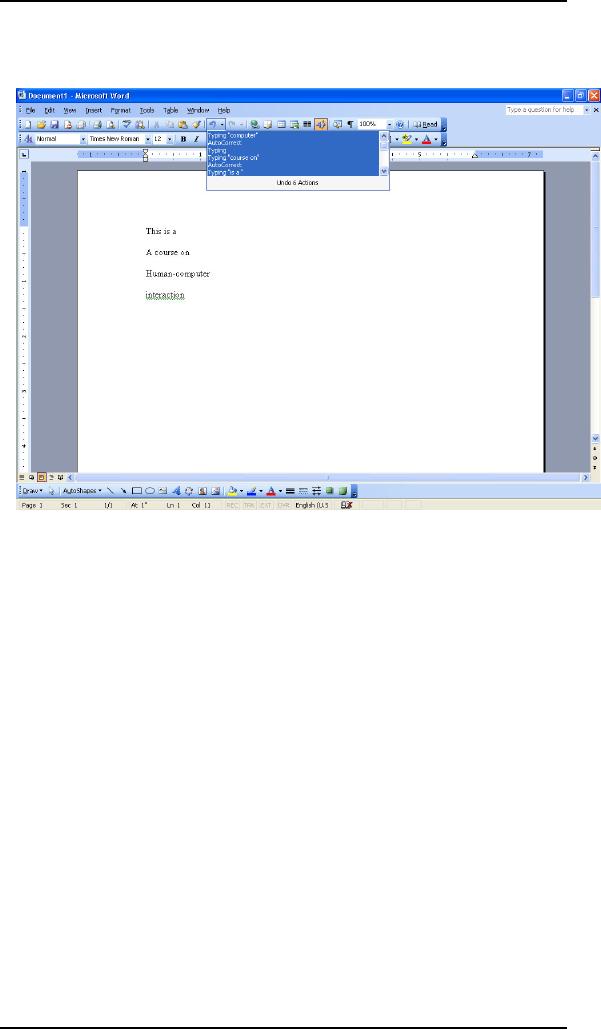 |

Human
Computer Interaction
(CS408)
VU
Lecture36
Lecture
36. Behavior
& Form Part IV
Learning
Goals
As the
aim of this lecture is to
introduce you the study of
Human Computer
Interaction,
so that after studying this
you will be able to:
� Understand
the significance of
undo
� Discuss
file and save
Understanding
undo
36.1
Undo is
the remarkable facility that
lets us reverse a previous action.
Simple and
elegant,
the feature is of obvious
value. Yet, when we examine
undo from a goal-
directed
point of view, there appears
to be a considerable variation in purpose
and
method.
Undo is critically important
for users, and it's
not quite as simple as
one
might
think. This lecture explores
the different ways users
think about undo and
the
different
uses for such a
facility.
Users
and Undo
Undo is
the facility traditionally
thought of as the rescuer of
users in distress; the
knight in
shining armor; the cavalry
galloping over the ridge;
the superhero swooping
in at the
last second.
As a
computational facility, undo
has no merit. Mistake-free as
they are, computers
have no
need for undo. Human beings,
on the other hand, make
mistakes all the
time,
and
undo is a facility that
exists for their exclusive
use. This singular
observation
should
immediately tell us that of
all the facilities in a
program, undo should be
modeled the
least
like its construction
methods---its implementation model --and
the most like the
user's
mental model.
Not
only do humans make mistakes, they
make mistakes as part of their
everyday
behavior.
From the standpoint of a
computer, a false start, a misdirected
glance, a
pause, a
hiccup, a sneeze, a cough, a
blink, a laugh, an "uh," a
"you know" are all
errors.
But from the standpoint of
the human user, they are
perfectly normal.
Human
mistakes
are so commonplace that if
you think of them as
"errors" or even as
abnormal
behavior, you will adversely
affect the design of your
software.
User
mental models of
mistakes
Users
don't believe, or at least don't
want to believe, that they
make mistakes. This is
another
way of saying that the
user's mental model doesn't
typically include error
on
his
part. Following the user's
mental model means absolving
the user of blame.
The
implementation
model, however, is based on an
error-free CPU. Following
the
implementation
model means proposing that
all culpability must rest
with the user.
Thus,
most software assumes that it is
blameless, and any problems are
purely the
fault of
the user.
327

Human
Computer Interaction
(CS408)
VU
The
solution is for the user
interface designer to completely
abandon the idea that
the
user
can make a mistake --
meaning that everything the
user does is something he
or
she
considers to be valid and reasonable. Users
don't like to admit to mistakes in
their
own
minds, so the program
shouldn't contradict these
actions in its interactions
with
users.
Undo
enables exploration
If we
design software from the
point of view that nothing
users do should constitute
a
mistake,
we immediately begin to see
things differently. We cease to
imagine the user
as a
module of code or a peripheral that
drives the computer, and we
begin to imagine
him as an
explorer, probing the
unknown. We understand that
exploration involves
inevitable
forays into blind alleys
and box canyons, down dead
ends and into
dry
holes. It
is natural for humans to experiment, to
vary their actions, to probe
gently
against
the veil of the unknown to
see where their boundaries
lie. How can they
know
what
they can do with a tool
unless they experiment with
it? Of course the degree
of
willingness
to experiment varies widely
from person to person, but most
people
experimental
least a little bit.
Programmers,
who are highly paid to think
like computers (Cooper, 1999),
view such
behavior
only as errors that must be handled by
the code. From the
implementation
model --
necessarily the programmer's
point of view such gentle,
innocent probing
represents
a continuous series of "mistakes".
From our more-enlightened,
mental
model
point-of-view, these actions
are natural and normal.
The program has
the
choice of
either rebuffing those perceived mistakes
or assisting the user in
his
explorations.
Undo is thus the primary
tool for supporting
exploration in software
user
interfaces.
It allows the user to reverse
one or more previous actions
if he decides to
change
his mind.
A
significant benefit of undo is
purely psychological: It reassures
users. It is much
easier to
enter a cave if you are
confident that you can
get back out of it at any
time.
The
undo function is that
comforting rope ladder to
the surface, supporting the
user's
willingness
to explore further by assuring him
that he can back out of
any dead-end
caverns.
Curiously,
users often don't think
about undo until they need
it, in much the same
way
that
homeowners don't think about
their insurance policies
until a disaster strikes.
Users
frequently charge into the cave
half prepared, and only
start looking for the
rope
ladder -- for undo -- after
they have encountered
trouble
Designing
an Undo Facility
Although
users need undo, it doesn't directly
support a particular goal
they bring to
their
tasks. Rather, it supports a necessary
condition -- trustworthiness -- on the
way
to a real
goal. It doesn't contribute positively to
attaining the user's goal,
but keeps
negative
occurrences from spoiling
the effort.
Users
visualize the undo facility
in many different ways
depending on the
situation
and
their expectations. If the
user is very computer-naive, he
might see it as an
unconditional
panic button for extricating
himself from a hopelessly
tangled
misadventure.
A more experienced computer
user might visualize undo as
a storage
facility
for deleted data. A really
computer-sympathetic user with a
logical mind
might
see it as a stack of procedures that can
be undone one at a time in reverse
order.
328

Human
Computer Interaction
(CS408)
VU
In order
to create an effective undo
facility, we must satisfy as many of
these mental
models as
we expect our users will
bring to bear.
The
secret to designing a successful
undo system is to make sure
that it supports
typically
used tools and avoids
any hint that undo
signals (whether visually,
audibly,
or
textually) a failure by the user. It
should be less a tool for
reversing errors and
more
one
for supporting exploration.
Errors are generally single,
incorrect actions.
Exploration,
by contrast, is a long series of probes
and steps, some of which
are
keepers
and others that must be
abandoned.
Undo
works best as a global,
program-wide function that undoes
the last action
regardless of
whether it was done by
direct manipulation or through a
dialog box.
This
can make undo problematic
for embedded objects. If the
user makes changes to
a
spreadsheet
embedded in a Word document,
clicks on the Word document,
and then
invokes
undo, the most recent Word
action is undone instead of
the most recent
spreadsheet
action. Users have a difficult
time with this. It fails to
render the juncture
between
the spreadsheet and the
word-processing document seamlessly: The
undo
function
ceases to be global and
becomes modal. This is not
an undo problem per
se,
but a
problem with the embedding
technology.
Types and
Variants of
36.2
As is so
common in the software
industry, there is no adequate
terminology to
describe
the types of undo that
exist -- they are uniformly
called undo and left at
that.
This
language gap contributes to
the lack of innovation in
new and better variants
of
undo. In
this section, we define
several undo variants and
explain their
differences.
Incremental and
procedural actions
36.3
First,
consider what objects undo
operates on: the user's
actions. A typical user
action
in a
typical application has a
procedure component--what the
user did -- and an
optional
data component -- what information
was affected. When the
user requests an
undo
function, the procedure
component of the action is reversed,
and if the action
had an
optional data component -- the
user added or deleted
data--that data will
be
deleted
or added back, as appropriate.
Cutting, pasting, drawing,
typing, and deleting
are all
actions that have a data
component, so undoing them
involves removing or
replacing
the affected text or image
parts. Those actions that include a
data
component
are ailed incremental
actions.
Many
undoable actions are
data-free transformations such as a
paragraph
reformatting
operation in a word processor or a
rotation in a drawing program.
Both
these
operations act on data but neither of
them add or delete data.
Actions like these
(with
only a procedure component) are
procedural actions. Most
existing undo
functions
don't discriminate between
procedural and incremental
actions but simply
reverse
the most recent action.
Blind
and explanatory undo
Normally,
undo is invoked by a menu
item or toolbar control with
an unchanging
label or
icon. The user knows
that triggering the idiom
undoes the last operation,
but
there is
no indication of what that
operation is. This is called
a blind undo. On the
other
hand, if the idiom includes
a textual or visual description of
the particular
operation
that will be undone it is an explanatory
undo. If, for example, the
user's last
329

Human
Computer Interaction
(CS408)
VU
operation
was to type in the word
design, the undo function on
the menu says
Undo
Typing
design. Explanatory undo is,
generally, a much more pleasant
feature than
blind
undo. It is fairly easy to
put on a menu item, but
more difficult to put on
a
toolbar
control, although putting
the explanation in a ToolTip is a
good compromise.
Single and
multiple undo
36.4
The
two most-familiar types of undo in common
use today are single
undo and multiple
undo.
Single undo is the most basic
variant, reversing the
effects of the most recent
user
action, whether procedural or
incremental. Performing a single undo twice
usually
undoes
the undo, and brings the
system back to the state it
was in before the first undo
was
activated.
This
facility is very effective
because it is so simple to operate.
The user interface is
simple
and clear, easy to describe
and remember. The user gets
precisely one free
lunch.
This is
by far the most frequently implemented
undo, and it is certainly adequate, if
not
optimal,
for many programs. For some
users, the absence of this
simple undo is sufficient
grounds
to abandon a product
entirely.
The
user generally notices most of
his command mistakes right
away: Something
about
what he did doesn't feel or
look right, so he pauses to
evaluate the situation. If
the
representation is
clear, he sees his mistake
and selects the undo
function to set things back
to
the
previously correct state;
then he proceeds.
Multiple
undo can be performed
repeatedly in succession -- it can
revert more than
one
previous
operation, in reverse temporal
order. Any program with simple
undo must
remember
the user's last operation
and, if applicable, cache any
changed data. If the
program
implements
multiple undo, it must maintain a stack
of operations, the depth of
which may be
settable
by the user as an advanced
preference. Each time undo is
invoked, it performs
an
incremental undo; it reverses
the most recent operation,
replacing or removing
data
as
necessary and discarding the
restored operation from the
stack.
LIMITATIONS OF SINGLE
UNDO
The
biggest limitation of single-level,
functional undo is when the
user accidentally
short-circuits
the capability of the undo
facility to rescue him. This
problem crops up
when
the user doesn't notice his
mistake immediately. For
example, assume he deletes
six
paragraphs of text, then deletes
one word, and then decides
that the six paragraphs
were
erroneously
deleted and should be
replaced. Unfortunately, performing undo
now merely
brings
back the one word,
and the six paragraphs
are lost forever. The undo function
has failed
him by
behaving literally rather than
practically. Anybody can clearly see
that the six
paragraphs
are more important than the
single word, yet the program
freely discarded
those
paragraphs
in favor of the one word.
The program's blindness
caused it to keep a
quarter
and
throw away a fifty-dollar bill,
simply because the quarter
was offered last.
In some
programs any click of the
mouse, however innocent of function it
might be, causes
the
single undo function to
forget the last meaningful
thing the user did.
Although
multiple
undo solves these problems,
it introduces some significant
problems of its
own.
LIMITATIONS OF
MULTIPLE UNDO
"The
response to the weaknesses of
single-level undo has been to
create a multiple-
level
implementation of the same,
incremental undo. The
program saves each
action
330

Human
Computer Interaction
(CS408)
VU
the
user takes. By selecting undo
repeatedly, each action can
be undone in the reverse
order of
its original invocation. In
the above scenario, the user
can restore the
deleted
word
with the first invocation of
undo and restore the
precious six paragraphs with
a
second
invocation. Having to redundantly
re-delete the single word is
a small price to
pay
for being able to recover
those six valuable paragraphs. The excise
of the one-
word
re-deletion tends to not be noticed,
just as we don't notice the
cost of ambulance
trips:
Don't quibble over the
little stuff when lives
are at stake. But this doesn't
change
the
fact that the undo mechanism
is built on a faulty model,
and in other
circumstances,
undoing functions in a strict
LIFO (Last In. First
Out) order can
make
the cure
as painful as the
disease.
Imagine
again our user deleting
six paragraphs of text, then
calling up another
document
and performing a global
find-and-replace function. In order to
retrieve the
missing
six paragraphs, the user must
first unnecessarily undo the
rather complex
global
find-and replace operation.
This time, the intervening
operation was not
the
insignificant
single-word deletion of the
earlier exam-pie. The
intervening operation
was
complex and difficult and
having to undo it is clearly an
unpleasant, excise effort.
It would
sure be nice to be able to
choose which operation in
the queue to undo and
to
be able
to leave intervening -- but
valid -- operations
untouched.
THE MODEL
PROBLEMS OF MULTIPLE UNDO
The
problems with multiple undo
are not due to its behavior
as much as they are
due
to its
manifest model. Most undo
facilities are constructed in an
unrelentingly
function-centric
manner. They remember what
the user does
function-by-function and
separate
the user's actions by
individual function. In the
time-honored way of
creating
manifest
models that follow
implementation models, undo
systems tend to model
code
and data
structures instead of user goals. Each
click of the Undo button
reverses
precisely
one function-sized bite of
behavior. Reversing on a
function-by-function
basis is
a very appropriate mental
model for solving most
simple problems caused
by
the
user making an erroneous entry.
Users sense it right away
and fix it right
away,
usually
within a two- or three-function limit.
The Paint program in Windows
95, for
example,
had a fixed, three-action
undo limit. However, when
the problem grows
more
convoluted, the incremental,
multiple undo models don't
scale up very well.
TOU
BET YOUR LIFO
When
the user goes down a
logical dead-end (rather
than merely mistyping data),
he
can
often proceed several
complex steps into the
unknown before realizing
that he is
lost
and needs to get a bearing
on known territory. At this point,
however, he may have
performed
several interlaced functions,
only some of which are
undesirable. He may
well
want to
keep some actions and
nullify others, not
necessarily in strict reverse
order. What if
the
user entered some text,
edited it, and then
decided to undo the entry of that
text but not
undo
the
editing of it? Such an operation is
problematic to implement and explain. Neil
Rubenking
offers
this pernicious example:
Suppose the user did a
global replace changing tragedy
to
331

Human
Computer Interaction
(CS408)
VU
catastrophe
and
then another changing cat
to
dog.
To
undo the first without
undoing the second,
can
the
program reliably fix all
the dogastrophes?
In this
more complex situation, the simplistic
representation of the undo as a single,
straight-
line,
LIFO stack doesn't satisfy
the way it does in-simpler
situations. The user may be
interested in
studying
his actions as a menu and
choosing a discontiguous subset of
them for reversion,
while
keeping
some others. This demands an
explanatory undo with a more robust
presentation than
might
otherwise be necessary for a
normal, blind, multiple
undo. Additionally, the
means
for
selecting from that
presentation must be more
sophisticated. Representing the operation
in
the to
clearly show the user
what he is actually undoing is a
more difficult problem.
Redo
The redo
function came into being as
the result of the implementation model
for undo,
wherein
operations must be undone in
reverse sequence, and in
which no operation may be
undone
without first undoing all of the
valid intervening operations. Redo
essentially
undoes
the undo and is easy to implement if
the programmer has already
gone to the effort to
implement
undo.
Redo
avoids a diabolical situation in multiple
undo. If the user wants to
back out of half-
dozen or
so operations, he clicks the Undo
control a few times, waiting
to see things return
to the
desired state. It is very
easy in this situation to
press Undo one time
too many. He
immediately
sees that he has undone
something desirable. Redo
solves this problem by
allowing
h i m to undo the undo, putting
back the last good
action.
Many
programs that implement single undo treat
the last undone action as an
undoable
action. In effect,
this makes a second
invocation of the undo function a
minimal redo
function.
Group
multiple undo
Microsoft
Word has an unusual undo
facility, a variation of multiple
undo we will call
group
multiple undo. It is multiple-level,
showing a textual description of each
operation in the
undo
stack. You can examine
the list of past operations
and select some operation in
the
list to
undo; however, you are not
undoing that one operation,
but rather all operations
back
to that
point, inclusive (see Figure on next
page).
Essentially,
you cannot recover the
six missing paragraphs without
first reversing all
the
intervening operations. After you
select one or more operations to undo,
the list of
undone operations is
now available in reverse order in the
Redo control. Redo works
exactly
the same way as undo works.
You can select as many
operations to redo as
desired
and all operations up to that specific
one will be redone.
332

Human
Computer Interaction
(CS408)
VU
The
program offers two visual
cues to this fact. If the
user selects the fifth
item in the list,
that
item and all four items
previous to it in the list
are selected. Also, the
text legend
says
''Undo 5 actions." The fact
that the designers had to
add that text legend
tells me
that,
regardless of how the
programmers constructed it, the
users were applying a
different
mental model. The users
imagined that they could go
down the list and
select
a single
action from the past to
undo. The program didn't
offer that option, so the
signs
were
posted. This is like the door with a pull
handle pasted with Push
signs -- which
everybody
still pulls on
anyway.
Other
Models for Undo-Like
Behavior
36.5
The
manifest model of undo in
its simplest form, single
undo, conforms to the
user's
mental
model: "I just did something
I now wish I hadn't done. I
want to click a button
and
undo
that last thing I did
"Unfortunately, this manifest model
rapidly diverges from the
user's
mental
model as the complexity of the
situation grows. In this
section, we discuss models
of
undo-like
behavior that work a bit
differently from the more
standard undo and redo
idioms.
Comparison:
What would this look
like?
Resides
providing robust support for
the terminally indecisive,
the paired undo-redo
function is
a
convenient comparison tool.
Say you'd like to compare
the visual effect of ragged-right
margins
against justified right
margins. Beginning with
ragged-right, you invoke
Justification.
Now
you click Undo to see
ragged-right and now you
press Redo to see justified
margins
again. In
effect, toggling between
Undo and Redo implements a
comparison or what-if
function;
it just happens to be represented in the
form of its implementation model. If this
same
333

Human
Computer Interaction
(CS408)
VU
function
were to be added to the
interface following the
user's mental model, it might
be
manifested
as a comparison control. This function
would let you repeatedly
take one step
forward
or backward to visually compare
two states.
Some Sony
TV remote controls include a function
labeled Jump, which switches
between the
current
channel and the previous
channel--very convenient for
viewing two programs
concurrently.
The jump function provides
the same usefulness as the
undo-redo function
pair
with a
single command--a 50%
reduction in excise for the
same functionality.
When used
as comparison functions, undo and
redo are really one
function and not two.
One
says
"Apply this change," and the
other says "Don't apply this
change." A single
Compare
button
might more accurately
represent the action to the
user. Although we have
been
describing
this tool in the context of
a text-oriented word processing program,
a compare
function
might be most useful in a
graphic manipulation or drawing program,
where the user is
applying
successive visual transformations on
images. The ability to see
the image with
the
transformation
quickly and easily compared
to the image without the
transformation would be
a great
help to the digital
artist.
Doubtlessly,
the compare function would
remain an advanced function. Just as
the jump
function is probably
not used by a majority of TV users,
the Compare button would
remain one
of those
niceties for frequent users.
This shouldn't detract from
its usefulness, however,
because
drawing
programs tend to be used
very frequently by those who
use them at all. For
programs
like
this, catering to the
frequent user is a reasonable
design choice.
Category-specific
Undo
The
Backspace key is really an undo
function, albeit a special
one. When the
user
mistypes,
the Backspace key "undoes"
the erroneous characters. If
the user mistypes
something,
then enters an unrelated function
such as paragraph reformatting, then
presses
the
Backspace key repeatedly, the mistyped
characters are erased and
the reformatting
operation is ignored.
Depending on how you look at
it, this can be a great
flexible advantage
giving
the user the ability to
undo discontiguously at any selected
location. You could also
see
it as a
trap for the user
because he can move the
cursor and inadvertently
backspace away
characters
that were not the last
ones keyed in.
Logic
says that this latter
case is a problem. Empirical
observation says that it
is
rarely a
problem for users. Such
discontiguous, incremental undo -- so
hard to explain in
words --
is so natural and easy to
actually use because
everything is visible: The
user
can
clearly see what will be
backspaced away. Backspace is a
classic example of an
incremental
undo, reversing only some
data while ignoring other,
intervening actions. Yet
if
you
imagined an undo facility
that had a pointer that
could be moved and that could
undo
the
last function that occurred
where the pointer points,
you'd probably t h i n k that such
a
feature
would be patently unmanageable and
would confuse the bejabbers
out of a typical
user.
Experience tells us that
Backspace does nothing of
the sort. It works as well as
it
does
because its behavior is
consistent wi t h the user's
mental model of the
cursor:
Because
it is the source of added
characters, it can also
reasonably be the locus of
deleted
characters.
Using
this same knowledge, we
could create different
categories of incremental undo,
like
a
format-undo function tha t
would only undo preceding
format commands and
other
334

Human
Computer Interaction
(CS408)
VU
types of
category-specific undo actions. If the user
entered some text, changed
it to italic,
entered
some more text, increased
the paragraph indentation, entered
some more text,
then
pressed
the Format-Undo key, only
the indentation increase would be
undone. A second
press
of the
Format-Undo key would reverse
the italicize operation. But neither
invocation of the
format-undo
would affect the
content.
What are
the implications of category-specific
undo in a non-text program? In
a
graphics
drawing program, for
example, there could be
separate undo commands
for
pigment
application tools, transformations,
and cut-and-paste. There is
really no
reason
why we couldn't have
independent undo functions
for each particular class
of
operation
in a program.
Pigment
application tools include all
drawing implements -- pencils,
pens, fills,
sprayers,
brushes -- and all shape tools --
rectangles, lines, ellipses,
arrows.
Transformations
include all image-manipulation
tools -- shear, sharpness,
hue, rotate,
contrast,
line weight. Cut-and-paste tools
include all lassos, marquees,
clones, drags,
and
other repositioning tools.
Unlike the Backspace
function in the word
processor,
undoing a
pigment application in a draw
program would be temporal
and would work
independently
of selection. That is, the
pigment that is removed first
would be the last
pigment
applied, regardless of the current
selection. In text, there is an
implied order from
the
upper-left to the lower-right.
Deleting from the
lower-right to the upper-left
maps
to a
strong, intrinsic mental
model; so it seems natural. In a
drawing, no such
conventional
order exists so any deletion order other
than one based on entry
sequence
would be
disconcerting to the
user.
A better
alternative might be to undo wit h i n
the current selection only.
The user
selects a
graphic object, for example, and requests
a transformation-undo. The last
transformation to
have been applied to that
selected
object would be
reversed.
Most
software users are familiar
with the incremental undo
and would find a
category-
specific undo
novel and possibly disturbing.
However, the ubiquitousness of
the Backspace
key
shows that incremental undo is a
learned behavior that users
find to be helpful. If
more
programs
had modal undo tools, users
would soon adapt to them.
They would even come
to
expect
them the way they
expect to find the Backspace
key on word
processors.
Deleted
data buffers
As the
user works on a document for
an extended time, his desire
for a repository of
deleted
text grows, it is not that he
finds the ability to incrementally undo
commands
useless
but rather that reversing actions can
cease to be so function-specific. Take
for
example,
our six missing paragraphs. If
they are separated from us
by a dozen complex
formatting
commands, they can be as
difficult to reclaim by undo as
they are to re-key.
The
user is
thinking, "If the program
would just remember the
stuff I deleted and keep it
in a
special
place, 1 could go get what I want
directly."
What
the user is imagining is a
repository of the data
components of his actions, rather
than
merely a LIFO stack of procedural -- a
deleted data buffer. The
user wants the
missing
text
with out regard to which
function elided it. The
usual manifest model forces him
not
only to
be aware of every intermediate step
but to reverse each of them,
in turn. To create a
facility
more amenable to the user,
we can create, in addition to the
normal undo
stack, an
independent buffer that
collects all deleted text or
data. At any time, the user
can
335

Human
Computer Interaction
(CS408)
VU
open
this buffer as a document
and use standard
cut-and-paste or click-and-drag idioms
to
examine
and recover the desired
text. If the entries in this
deletion buffer are headed
with
simple
date stamps and document
names, navigation would be
very simple and
visual
The
user could browse the buffer
of deleted data at will, randomly,
rather than
sequentially.
Finding those six missing
paragraphs would be a simple,
visual procedure,
regardless
of the number or type of complex,
intervening steps he had taken. A
deleted data
buffer
should be offered in addition to the
regular, incremental, multiple
undo because
it
complements it. The data must be
saved in a buffer, anyway. This feature
would be quite
useful in
all programs, too, whether spreadsheet,
drawing program, or invoice
generator.
Mile
stoning and reversion
Users
occasionally want to back up
long distances, but when
they do, the
granular
actions
are not terrifically important.
The need for an incremental
undo remains, but
discerning
the individual components of
more than the last
few operations is overkill in
most
cases.
Milestoning, simply makes a copy of
the entire document the
way a camera snapshot
freezes
an image in time. Because
milestoning involves the entire
document, it is always
implemented
by direct use of the file
system. The biggest difference between
milestoning and
other
undo systems is that the
user must explicitly request
the milestone -- recording a copy
or
snapshot
of the document. After he
has done this, he can
proceed to safely modify
the
original.
If he later decides that his
changes were undesirable, he
can return to the
saved
copy--a
previous version of the document.
Many
tools exist to support the
milestoning concept in source code; but
as yet, no
programs
the authors are aware of
present it directly to the
user. Instead, they rely on
the file
system's
interface, which, as we have seen, is
difficult for many users to
understand. If
milestoning
were rendered in a non-file-system user
model, implementation would
be
quite
easy, and its management
would be equally simple. A
single button control
could
save
the document in its current
state. The user could save as many
versions at any interval
as
he
desires. To return to a previously
milestoned version, the user
would access a reversion facility.
The
reversion facility is extremely simple --
too simple, perhaps. Its
menu item merely
says,
Revert to Milestone. This is
sufficient for a discussion of the
file system; but
when
considered as part of an undo function,
it should offer more information.
For
example, it
should display a list of the available
saved versions of that document
along with
some
information about each one,
such as the time and day it
was recorded, the
name
of the
person who recorded it. the
size, and some optional
user-entered notes. The
user
could
choose one of these versions,
and the program would
load it, discarding
any
intervening
changes.
Freezing
Freezing,
the opposite of milestoning,
involves locking the data in a
document so that
it cannot
be changed. Anything that
has been entered becomes
unmodifiable, although new
data
can be
added. Existing paragraphs
are untouchable, but new
ones can be added between
older
ones.
This
method is much more useful
for a graphic document than
for a text document. It is
much
like an
artist spraying a drawing with
fixative. All marks made up to
that point are
now
permanent,
yet new marks can be
made at will. Images already
placed on the screen are
locked
down and
cannot be changed, but new
images can be freely
superimposed on the older
336

Human
Computer Interaction
(CS408)
VU
ones.
Procreate Painter offers a
similar feature with its
Wet Paint and Dry
Paint
commands.
Undo
Proof Operation
Some
operations simply cannot be
undone because they involve
some action that
triggers
a device � not under the
direct control of the program.
After an e-mail message
has
been
sent, for example, ^ there
is no undoing it. After a
computer has been turned
off
without
saving data, there is no
undoing the loss. Many
operations, however,
masquerade
as undo-proof, but they are
really easily reversible.
For example, when you
save a
document for the first
time in most programs, you
can choose a name for
the file. But
almost no
program lets you rename
that file. Sure, you
can Save As under another
name, but
that just
makes another
file
under the new name, leaving
the old file untouched under
the
old
name. Why isn't a filename undo provided?
Because it doesn't fall into
^ the traditional
view of
what undo is for, programmers generally
don't provide a true undo
function for
changing
a filename. Spend some time
looking at your own
application and see if
you
can
find functions that seem as if
they should be undoable, but
currently aren't. You may
be
surprised
by how many you find.
Rethinking
Files and Save
36.6
If you
have ever tried to teach
your mom how to use a
computer, you will know
that
difficult
doesn't
really do the problem justice. Things
start out ail right: Start
up the
word
processor and key in a
letter. She's with you all
the way. When you
are finally done,
you
click the Close button, and
up pops a dialog box asking
"Do you want to
save
changes?"
You and Mom h i t the wall
together. She looks at you
and asks, "What
does
this
mean: "Is everything
okay?"
The
part of modern computer
systems that is the most
difficult for users to understand
is
the file
system, the facility that
stores programs and data
files on disk. Telling
the
uninitiated
about disks is very difficult. The
difference between main memory and
disk
storage
is not clear to most people.
Unfortunately, the way we
design our software
forces
users --
even your mom -- to know
the difference. This chapter provides a
different way of
presenting
interactions involving files and
disks -- one that is more in
harmony with the
mental
models of our users.
What's
Wrong with Saving Changes to
Files?
Every
program exists in two places
at once: in memory and on
disk. The same is
true
of every
file. However, most users
never truly grasp the
difference between memory and
disk
storage and how it pertains to
the tasks they perform on
documents in a computer
system.
Without a doubt, the file
system -- along with the
disk storage facility it
manages
-- is the
primary cause of disaffection
with computers among
non-computer-professionals.
When that
Save Changes? dialog box,
shown in Figure, opens users
suppress a twinge of
fear
and confusion and click
the Yes button out of
habit. A dialog box that is
always
answered
the same way is a redundant
dialog box that should be
eliminated.
The
Save Changes dialog box is
based on a poor assumption: that
saving and not saving
are
equally probable behaviors.
The dialog gives equal
weight to these two
options
even
though the Yes button is
clicked orders of magnitude more
frequently than the No
button.
As discussed in Chapter 9, this is a case
of confusing possibility and
probability.
The
user might
say
no, but the user
will
almost always say
yes. Mom is thinking, "If
1
337

Human
Computer Interaction
(CS408)
VU
didn't
want those changes, why
would I have closed the
document with them in
there?" To
her,
the question is absurd.
There's something else a bit
odd about this dialog: Why
does it
only
ask about saving changes when
you are all done?
Why didn't it ask when you
actually
made
them? The connection between
closing a document and saving
changes isn't all
that
natural, even
though power users have
gotten quite familiar with
it.
The
program issues the Save
Changes dialog box when the
user requests Close or
Quit
because
that is the time when it
has to reconcile the
differences between the copy
of
the
document in memory and the
copy on the disk. The way
the technology
actually
implements
the facility associates
saving changes with Close
and Quit, but the
user sees no
connection.
When we leave a room, we don't consider discarding
all the changes we
made
while we
were there. When we put a
book back on the shelf, we don't
first erase any
comments
we wrote in the
margins.
As
experienced users, we have
learned to use this dialog
box for purposes for
which it was
never
intended. There is no easy way to
undo massive changes, so we
use the Save
Changes
dialog by
choosing No. If you discover
yourself making big changes to
the wrong file,
you
use
this dialog as a kind of
escape valve to return things to the
status quo. This is handy,
but
it's also
a hack: There are better ways to
address these problems (such
as an obvious Revert
function).
So what is the real problem?
The file systems on modern
personal computer
operating
systems, like Windows XP or Mac OS X,
are technically excellent. The
problem
Mom is
having stems from the
simple mistake of faithfully rendering
that excellent
implementation model
as an interface for
users.
Problems
with the Implementation
Model
The
computer's file system is
the tool it uses to manage
data and programs stored on
disk. This
means
the large hard disks
where most of your information
resides, but it also includes
your
floppy
disks, ZIP disks, CD-ROMs,
and DVDs if you have
them. The Finder on the
Mac and the
Explorer in
Windows graphically represent
the file system in all
its glory.
Even
though the file system is an
internal facility that
shouldn't -- by all rights --
affect the user, it
creates a
large problem because the
influence of the file system
on the interface of most
programs
is very
pervasive. Some of the most
difficult problems facing
interaction designers concern
the file
system
and its demands. It affects
our menus, our dialogs, even
the procedural framework of
our
programs;
and this influence is likely
to continue indefinitely unless we
make a concerted effort to
stop
it.
Currently,
most software treats the file
system in much the same
way that the
operating
system shell does (Explorer.
Kinder). This is tantamount to
making you
deal
with your car in the same
way a mechanic does.
Although this approach
is
unfortunate
from an interaction perspective, it is a
de facto standard, and there
is
considerable
resistance to improving
it,
Closing
and unwanted changes
We
computer geeks are conditioned to t h i n
k that Close is the time
and place for
abandoning
unwanted changes if we make
some error or are just
noodling around. This is
not
correct because the proper
time to reject changes is
when the changes are
made. We
even have
a well-established idiom to support this:
The Undo function is the
proper
facility
for eradicating changes.
338

Human
Computer Interaction
(CS408)
VU
Save
As
When
you answer yes to the Save Changes
dialog, many programs then
present you
with
the Save As dialog
box.
Most
users don't understand the
concept of manual saving
very well, so from
their
point of
view, the existing name of
this dialog box doesn't make
much sense.
Functionally,
this dialog offers two
things: It lets users name a file, and it
lets them
choose
which directory to place it in.
Both of these functions demand
intimate
knowledge
of the file system. The user
must know how to formulate a filename
and how to
navigate through
the file directory. Many users
who have mastered the name
portion have
completely
given up on understanding the directory
tree. They put their
documents in
the
directory that the program chooses
for a default. All t h e i r files
are stored in a
single
directory.
Occasionally, some action will
cause the program to forget
its default directory,
and these
users must call in an expert
to find their files for
them.
The Save
As dialog needs to decide
what its purpose truly is.
If it is to name and
place
files, then it does a very
poor job. After the
user has named and placed a
file, he
cannot
then change its name or its
directory -- at least not with
this dialog, which
purports
to offer naming and placing
functions -- nor can he with
any other tool in
the
application itself. In fact, in
Windows XP, you can rename
other
files
using this
dialog,
hut not
the
ones you are currently
working on. Huh? The
idea, one supposes,
is to
allow you to rename other
previously saved milestones of your
document
because
you can't rename the current
one. But both operations
ought to be possible
and be
allowed.
Beginners
are out of luck, but
experienced users learn the
hard way that they
can close
the
document, change to the Explorer, rename
the file, return to the
application,
summon
the Open dialog from
the File menu, and
reopen the document. In case
you
were
wondering, the Open dialog
doesn't allow renaming or repositioning
either,
except in
the bizarre cases mentioned
in the previous
paragraph.
Forcing
the user to go to the
Explorer to rename the document is a
minor hardship,
but
therein lies a hidden trap.
The bait is that Windows easily
supports several applications
running
simultaneously. Attracted by this feature, the
user tries to rename the file in
the
Explorer
without first closing the
document in the application.
This very reasonable
action
triggers the trap, and
the steel jaws clamp down
hard on his leg. He is
rebuffed
with a
rude error message box. He
didn't first close the
document -- how would he
know?
Trying to
rename an open file is a
sharing violation, and the
operating system rejects it
with a
patronizing error message
box.
The
innocent user is merely
trying to rename his document,
and he finds himself
lost
in an ,
archipelago of operating system
arcana. Ironically, the one
entity that has
both
the
authority and the
responsibility to change the document's
name while it is
still
open,
the application itself,
refuses to even try.
Archiving
36.7
There is
no explicit function for
making a copy of. or
archiving, a document. The
user
must
accomplish this with the
Save As dialog, and doing so is as
clear as mud. Even if
there
were a Copy * command, users
visualize this function
differently. If we are
339

Human
Computer Interaction
(CS408)
VU
working,
for example, on a document
called Alpha, some people
imagine that we
would
create a file called Copy of
Alpha and store that away.
Others imagine that we
put
Alpha away and continue
work on Copy of
Alpha.
The
latter option will likely
only occur to those who
are already experienced with
the
implementation
model of file systems. It is
how we do it today with the
Save As
dialog:
You have already saved the
file as Alpha; and then
you explicitly call up
the
Save As
dialog and change the name.
Alpha is closed and put away
on disk, and Copy
of Alpha
is left open for editing.
This action makes very
little sense from a
single-
document
viewpoint of the world, and
it also offers a really
nasty trap for the
user
Here is
the completely reasonable scenario that
leads to trouble: Let's say
that you
have been
editing Alpha for the
last twenty minutes and
now wish to make an
archival
copy of
it on disk so you can make
some big but experimental
changes to the
original.
You
call'up the Save As dialog
box and change the file
name to New Alpha.
The
program
puts Alpha away on disk
leaving you to edit New
Alpha. But Alpha
was
never
saved, so it gets written to disk
without any of the changes
you made in the
last
twenty
minutes! Those changes only
exist in the New Alpha
copy that is currently
in
memory --
in the program. As you begin
cutting and pasting in New
Alpha, trusting
that
your handiwork is backed up by
Alpha, you are actually
modifying the sole
copy
of this
information.
Everybody
knows that you can
use a hammer to drive a
screw or pliers to bash in
a
nail,
but any skilled craftsperson
knows that using the
wrong too! for the
job will
eventually
catch up with you. The tool
will break or the work will be
hopelessly
ruined.
The Save As dialog is the
wrong tool for making
and managing copies, and
it
is the
user who will eventually
have to pick up the
pieces.
Implementation
Model versus Mental
Model
36.8
The
implementation model of the
file system runs contrary to
the mental model
almost
all users bring to it.
Most users picture electronic
files like printed documents in
the
real
world, and they imbue
them with the behavioral
characteristics of those real
objects.
In the simplest terms, users
visualize two salient facts
about all documents:
First,
there is
only one document; and
second, it belongs to them. The file
system's
implementation
model violates both these
rules: There are always two
copies of the
document,
and they both belong to the
program.
Every
data file, every document,
and every program, while in
use by the computer,
exists in
two places at once: on disk
and in main memory. The
user, however,
imagines
his document as a book on a shelf.
Let's say it is a journal. Occasionally,
it
comes
down off the shelf to
have something added to it.
There is only one journal,
and it
either
resides on the shelf or it resides in
the user's hands. On the
computer, the disk
drive is
the shelf, and main
memory is the place where
editing takes place,
equivalent
to the
user's hands. But in the
computer world, the journal
doesn't come off the
shelf.
Instead a
copy is made, and that copy
is
what resides in computer
memory. As the
user
makes changes to the
document, he is actually making
changes to the copy
in
memory,
while the original remains
untouched on disk. When the
user is done and
closes
the document, the pro
gram is faced with a
decision: whether to replace
the
original
on disk with the changed
copy from memory, or to
discard the altered
copy.
Prom
the programmer's point of
view, equally concerned with
all possibilities,
this
choice
could go either way. From
the software's implementation
model point of view,
the
choice is the same either
way. However, from the
user's point of view, there
is no
decision
to be made at all. He made
his changes, and now he is
just putting the
340

Human
Computer Interaction
(CS408)
VU
document
away. If this were happening
with a paper journal in the
physical world, the
user
would have pulled it off
the shelf, penciled in some
additions, and then
replaced
it on the
shelf. It's as if the shelf
suddenly were to speak up,
asking him if he
really
wants to
keep those changes
Dispensing with
the Implementation Model of the
36.9
File
System
Right
now, serious programmer-type readers
are beginning to squirm in
their seats.
They
are thinking that we're treading on holy
ground: A pristine copy on disk is
a
wonderful
thing, and we'd better
not advocate getting rid of
it. Relax! There is nothing
wrong
with our
file systems. We simply need to hide
its existence from the
user. We can still offer
to
him all
the advantages of that extra
copy on disk without exploding
his mental model.
If we
begin to render the file
system according to the
user's mental model we
achieve
a
significant advantage: We can
all teach our moms
how to use computers. We
won't have
to answer
her pointed questions about
the inexplicable behavior of the
interface. We can
show
her the program and
explain how it allows her to
work on the document; and,
upon
completion,
she can store the document
on the disk as though it were a journal
on a shelf.
Our
sensible explanation won't be
interrupted by that Save Changes?
dialog. And Mom
is
representative of the mass-market of computer
buyers.
Another
big advantage is that
interaction designers won't have to
incorporate clumsy
file
system awareness into their
products. We can structure
the commands in our
programs
according
to the goals of the user
instead of according to the
needs of the operating
system.
We no longer
need to call the left-most
menu the File menu.
This nomenclature is a
bold
reminder of
how technology currently
pokes through the facade of
our programs.
Changing
the
name and contents of the
File menu violates an
established, though
unofficial,
standard.
But the benefits will far
outweigh any dislocation the
change might cause.
There
will certainly be an
initial cost as experienced users
get used to the new
presentation, but it
will be
far less than you
might suppose. This is because
these power users have
already
shown
their ability and tolerance
by learning the implementation
model. For them,
learning
the better model will be no
problem, and there will be no
loss of functionality
for
them. The
advantage for new users will
be immediate and significant. We
computer
professionals
forget how tall the mountain
is after we've climbed it. but
everyday
newcomers
approach the base of this
Everest of computer literacy
and are severely
discouraged.
Anything we can do to lower
the heights they must
scale will make a
big
difference,
and this step will tame some
of the most perilous
peaks.
Designing a
Unified File Presentation
Model
36.10
Properly
designed software will always
treat documents as single instances,
never as
a copy on
disk and a copy in memory: a
unified file model. It's the
file system's job to
manage
information not in main memory,
and it does so by maintaining a
second copy on
disk.
This method is correct, but
it is an implementation detail that only
confuses the
user.
Application software should conspire
with the file system to hide
this unsettling
detail
from the user. If the file
system is going to show the
user a file that cannot
be
changed
because it is in use by another
program, the file system should indicate
this to the
user.
Showing the filename in red
or with a special symbol next to it
would be sufficient. A
new
user might still get an
error message as shown in Figure 33-3; but, at
least, some visual
clues
would be present to show him
that there was a reason
why
that error cropped
up.
341

Human
Computer Interaction
(CS408)
VU
Not
only are there two copies of
all data files in the
current model, but when
they are
running,
there are two copies of all
programs. When the user
goes to th e Taskbar's
Start
menu and launches his word
processor, a button corresponding to Word
appears on
the Taskbar.
But if he returns to the Start menu. Word
is still there! Prom the users
point of
view, he has pulled his
hammer out of his toolbox
only to find that there is
still a
hammer in
his toolbox!
This
should probably not be
changed; after all, one of
the strengths of the computer
is
its
capa bility to have multiple copies of
software running simultaneously. But
the
software should
help the user to understand this
very non-intuitive action.
The Start
menu
could, for example make some
reference to the already running
program.
342
Table of Contents:
- RIDDLES FOR THE INFORMATION AGE, ROLE OF HCI
- DEFINITION OF HCI, REASONS OF NON-BRIGHT ASPECTS, SOFTWARE APARTHEID
- AN INDUSTRY IN DENIAL, SUCCESS CRITERIA IN THE NEW ECONOMY
- GOALS & EVOLUTION OF HUMAN COMPUTER INTERACTION
- DISCIPLINE OF HUMAN COMPUTER INTERACTION
- COGNITIVE FRAMEWORKS: MODES OF COGNITION, HUMAN PROCESSOR MODEL, GOMS
- HUMAN INPUT-OUTPUT CHANNELS, VISUAL PERCEPTION
- COLOR THEORY, STEREOPSIS, READING, HEARING, TOUCH, MOVEMENT
- COGNITIVE PROCESS: ATTENTION, MEMORY, REVISED MEMORY MODEL
- COGNITIVE PROCESSES: LEARNING, READING, SPEAKING, LISTENING, PROBLEM SOLVING, PLANNING, REASONING, DECISION-MAKING
- THE PSYCHOLOGY OF ACTIONS: MENTAL MODEL, ERRORS
- DESIGN PRINCIPLES:
- THE COMPUTER: INPUT DEVICES, TEXT ENTRY DEVICES, POSITIONING, POINTING AND DRAWING
- INTERACTION: THE TERMS OF INTERACTION, DONALD NORMAN’S MODEL
- INTERACTION PARADIGMS: THE WIMP INTERFACES, INTERACTION PARADIGMS
- HCI PROCESS AND MODELS
- HCI PROCESS AND METHODOLOGIES: LIFECYCLE MODELS IN HCI
- GOAL-DIRECTED DESIGN METHODOLOGIES: A PROCESS OVERVIEW, TYPES OF USERS
- USER RESEARCH: TYPES OF QUALITATIVE RESEARCH, ETHNOGRAPHIC INTERVIEWS
- USER-CENTERED APPROACH, ETHNOGRAPHY FRAMEWORK
- USER RESEARCH IN DEPTH
- USER MODELING: PERSONAS, GOALS, CONSTRUCTING PERSONAS
- REQUIREMENTS: NARRATIVE AS A DESIGN TOOL, ENVISIONING SOLUTIONS WITH PERSONA-BASED DESIGN
- FRAMEWORK AND REFINEMENTS: DEFINING THE INTERACTION FRAMEWORK, PROTOTYPING
- DESIGN SYNTHESIS: INTERACTION DESIGN PRINCIPLES, PATTERNS, IMPERATIVES
- BEHAVIOR & FORM: SOFTWARE POSTURE, POSTURES FOR THE DESKTOP
- POSTURES FOR THE WEB, WEB PORTALS, POSTURES FOR OTHER PLATFORMS, FLOW AND TRANSPARENCY, ORCHESTRATION
- BEHAVIOR & FORM: ELIMINATING EXCISE, NAVIGATION AND INFLECTION
- EVALUATION PARADIGMS AND TECHNIQUES
- DECIDE: A FRAMEWORK TO GUIDE EVALUATION
- EVALUATION
- EVALUATION: SCENE FROM A MALL, WEB NAVIGATION
- EVALUATION: TRY THE TRUNK TEST
- EVALUATION – PART VI
- THE RELATIONSHIP BETWEEN EVALUATION AND USABILITY
- BEHAVIOR & FORM: UNDERSTANDING UNDO, TYPES AND VARIANTS, INCREMENTAL AND PROCEDURAL ACTIONS
- UNIFIED DOCUMENT MANAGEMENT, CREATING A MILESTONE COPY OF THE DOCUMENT
- DESIGNING LOOK AND FEEL, PRINCIPLES OF VISUAL INTERFACE DESIGN
- PRINCIPLES OF VISUAL INFORMATION DESIGN, USE OF TEXT AND COLOR IN VISUAL INTERFACES
- OBSERVING USER: WHAT AND WHEN HOW TO OBSERVE, DATA COLLECTION
- ASKING USERS: INTERVIEWS, QUESTIONNAIRES, WALKTHROUGHS
- COMMUNICATING USERS: ELIMINATING ERRORS, POSITIVE FEEDBACK, NOTIFYING AND CONFIRMING
- INFORMATION RETRIEVAL: AUDIBLE FEEDBACK, OTHER COMMUNICATION WITH USERS, IMPROVING DATA RETRIEVAL
- EMERGING PARADIGMS, ACCESSIBILITY
- WEARABLE COMPUTING, TANGIBLE BITS, ATTENTIVE ENVIRONMENTS